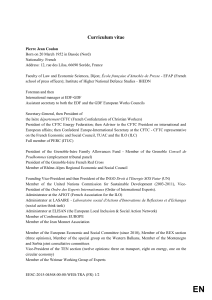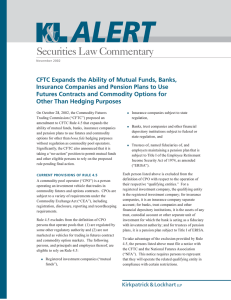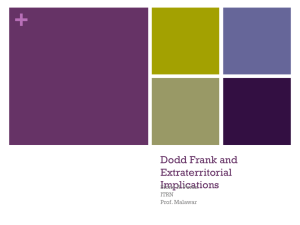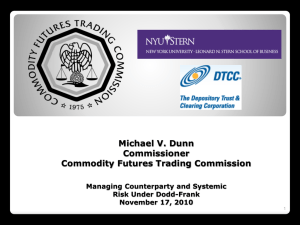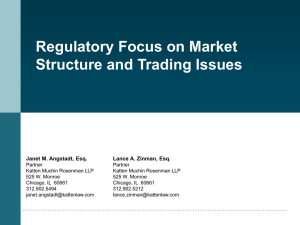Revised Defi nition of “Commodity Interests” Has Implications for Closed-End Funds
advertisement
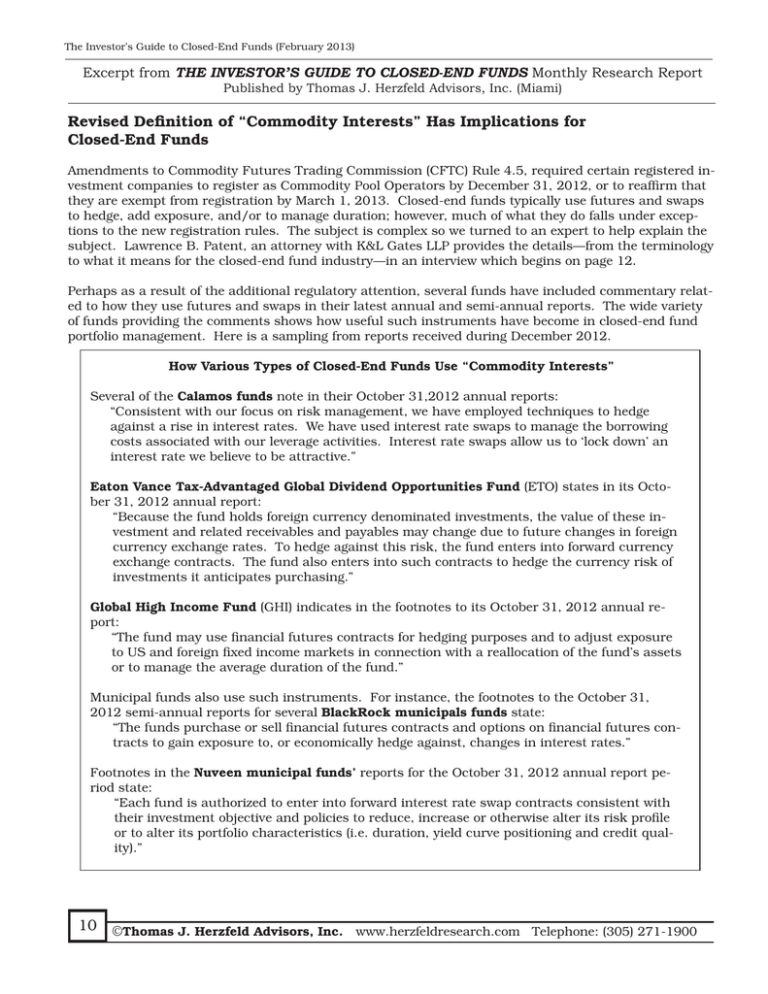
The Investor’s Guide to Closed-End Funds (February 2013) Excerpt from THE INVESTOR’S GUIDE TO CLOSED-END FUNDS Monthly Research Report Published by Thomas J. Herzfeld Advisors, Inc. (Miami) Revised Definition of “Commodity Interests” Has Implications for Closed-End Funds Amendments to Commodity Futures Trading Commission (CFTC) Rule 4.5, required certain registered investment companies to register as Commodity Pool Operators by December 31, 2012, or to reaffirm that they are exempt from registration by March 1, 2013. Closed-end funds typically use futures and swaps to hedge, add exposure, and/or to manage duration; however, much of what they do falls under exceptions to the new registration rules. The subject is complex so we turned to an expert to help explain the subject. Lawrence B. Patent, an attorney with K&L Gates LLP provides the details—from the terminology to what it means for the closed-end fund industry—in an interview which begins on page 12. Perhaps as a result of the additional regulatory attention, several funds have included commentary related to how they use futures and swaps in their latest annual and semi-annual reports. The wide variety of funds providing the comments shows how useful such instruments have become in closed-end fund portfolio management. Here is a sampling from reports received during December 2012. How Various Types of Closed-End Funds Use “Commodity Interests” Several of the Calamos funds note in their October 31,2012 annual reports: “Consistent with our focus on risk management, we have employed techniques to hedge against a rise in interest rates. We have used interest rate swaps to manage the borrowing costs associated with our leverage activities. Interest rate swaps allow us to ‘lock down’ an interest rate we believe to be attractive.” Eaton Vance Tax-Advantaged Global Dividend Opportunities Fund (ETO) states in its October 31, 2012 annual report: “Because the fund holds foreign currency denominated investments, the value of these investment and related receivables and payables may change due to future changes in foreign currency exchange rates. To hedge against this risk, the fund enters into forward currency exchange contracts. The fund also enters into such contracts to hedge the currency risk of investments it anticipates purchasing.” Global High Income Fund (GHI) indicates in the footnotes to its October 31, 2012 annual report: “The fund may use financial futures contracts for hedging purposes and to adjust exposure to US and foreign fixed income markets in connection with a reallocation of the fund’s assets or to manage the average duration of the fund.” Municipal funds also use such instruments. For instance, the footnotes to the October 31, 2012 semi-annual reports for several BlackRock municipals funds state: “The funds purchase or sell financial futures contracts and options on financial futures contracts to gain exposure to, or economically hedge against, changes in interest rates.” Footnotes in the Nuveen municipal funds’ reports for the October 31, 2012 annual report period state: “Each fund is authorized to enter into forward interest rate swap contracts consistent with their investment objective and policies to reduce, increase or otherwise alter its risk profile or to alter its portfolio characteristics (i.e. duration, yield curve positioning and credit quality).” 10 ©Thomas J. Herzfeld Advisors, Inc. www.herzfeldresearch.com Telephone: (305) 271-1900 The Investor’s Guide to Closed-End Funds (February 2013) Still Off Key We have not yet spotted any closed-end funds that have announced they will now fall under CFTC oversight; however, a recent article on TheMutualFundWire.com mentions three open-end funds have filed as Commodity Pool Operators. The article, titled “Three Funds Veer Into CFTC Territory,” quotes SEC filings for Columbia Funds disclosing, “Until the CFTC’s and SEC’s overlapping regulations on matters such as disclosure, reporting and recordkeeping are harmonized, the nature and extent of the impact of new CFTC requirements on these funds is uncertain. Compliance with the CFTC’s new regulatory requirements could increase fund expenses, adversely affecting a fund’s total return.” “Harmonization” is the official term used to describe the integration of CFTC and SEC regulations and, from the reviews we’ve read, it will be far from easy. The two agencies have different requirements related to the content of disclosure documents, delivery of disclosure information to prospective investors, performance reporting for commodity pools in existence less than three years, the frequency and nature of periodic reports to investors as well as varying recordkeeping rules. The concept of “harmonization” was introduced in early 2012 but has yet to be completed even as the new rules go into effect. Until the nuts and bolts of “harmonization” are worked out and the full impact of additional CFTC oversight is clear, it seems closed-end funds are opting to limit their use of “commodity interests” in order to continue to fall within the exempted parameters. Some funds are formally limiting their use of “commodity interests” going forward, to ensure they remain under the Rule 4.5 exemption. For example, several of the Guggenheim funds, including the three Advent/Claymore funds and Guggenheim Enhanced Equity Strategy Fund (GGE), each indicate in their annual reports, “beginning January 1, 2013, the fund will limit its transactions in futures, option of futures and swaps (excluding transactions entered into for ‘bona fide hedging purposes,’ as defined under CFTC regulations)…” They point out that although they are adding the restriction, “The fund and its investment advisor do not believe that complying with the amended rule will limit the fund’s ability to use futures, options and swaps to the extent that it has used them in the past.” To offer investors more exposure to investments considered “commodity interests,” at least one closedend fund sponsor has decided to divide and conquer—launching two new funds as commodity pools rather than as closed-end funds: Nuveen Diversified Commodity Fund (CFD), brought to market in 2010, and Nuveen Long/Short Commodity Total Return Fund (CTF), launched late last year. ©Thomas J. Herzfeld Advisors, Inc. 119 Washington Ave., Suite 504, Miami Beach, FL 33139 11 The Investor’s Guide to Closed-End Funds (February 2013) New CFTC Rules Impact Closed-End Funds Interview with Lawrence B. Patent, Esq. K&L Gates LLP 202-778-9000 Lawrence.patent@klgates.com New rules stemming from The Dodd-Frank Wall Street Reform and Consumer Protection Act, signed into law on July 21, 2010, are now being implemented. One portion of the new legislation, in particular, has implications for the closedend fund industry; it appears under Title VII – Wall Street Transparency and Accountability. The focus is on commodities and swaps, areas in which few existing closed-end funds currently concentrate. Nevertheless, the rule is triggering the need for funds to make a determination now and potentially register for additional regulatory oversight by the Commodity Futures Trading Commissions (CFTC). K&L Gates LLP is ranked among the top U.S. corporate law firms and it has been releasing ongoing guidance on the new CFTC registration requirements through its Legal Insight notices. One recent notice highlighted the requirement for funds to reaffirm if they are exempt from CFTC registration before March 1, 2013. The full release is available at: http://www.klgates.com/nfa-issues-guidance-on-reaffirmation-of-cpocta-exemptions-12-12-2012/ Lawrence B. Patent, Esq, one of the authors of the Notice, granted us this interview on the subject. CG: Thank you for agreeing to talk to us, Larry. Let’s start by looking at some of the abbreviations that keep coming up. What do CFTC, NFA, CPO and CTA refer to and how do they relate to this topic? distinction between entities that organize the pool and solicit investors and those that make trading decisions. A CTA is analogous to an investment advisor on the securities side. CG: The first confusing part of the new rules is that an affirmation needs to be made by registered LP: CFTC – Commodity Futures Trading Commisinvestment companies (RICs) if they are NOT subsion is the government agency that administers the ject to registration with the CFTC, so that puts the Commodity Exchange Act. It is essentially the counburden on every RIC trading commodity interests to terpart of the Securities and Exchange Commission (SEC) but for the futures industry, which now encom- make such a determination. In the past, how was affirmation made and what has changed? passes futures and swaps, referred to as “commodity interests.” Swaps were LP: RICs trading commodadded as part of Dodd- “RICs trading commodity interests previously had a blanket exemption from CFTC registration ity interests previously had a Frank. regardless of the amount of trading.” blanket exemption from CFTC registration regardless of the NFA – National FuLawrence B. Patent, Esq. amount of trading. To claim tures Association is K&L Gates LLP that exemption, the fund would the industry-funded file a one-time notice at inception claiming an exempself-regulatory organization; the futures countertion with the NFA. part of the Financial Industry Regulatory Authority, FINRA. Going forward, the RIC must make an annual reaffirCPO – Commodity Pool Operator is the term used in mation of its reliance on the exemption. If the fund had an initial filing dated before December 31, 2012, it now the Commodity Exchange Act to refer to the operator has until before March 1, 2013 to file a reaffirmation. of a collective investment vehicle that trades in “commodity interests.” The RIC exemptions are detailed under CFTC Regulation 4.5, which was recently amended. There are CTA – Commodity Trading Advisor is the person allowances for using commodity interests for bona fide or entity that, for compensation or profit, advises on hedging activities, as well as allowances for engaging in trading in “commodity interests.” Although a CPO a de minimus amount of non-hedge trading. could also perform that function, there is usually a 12 ©Thomas J. Herzfeld Advisors, Inc. www.herzfeldresearch.com Telephone: (305) 271-1900 The Investor’s Guide to Closed-End Funds (February 2013) CG: A reprint of your summary of these exemptions is presented in the box on page 15 and we thank you for allowing us to include it. The information is taken from the K&L Gates February 17, 2012 Legal Insight Notice. It can reaffirm exemptions for the other 14 pools and may operate them without having to comply with CFTC regulations. For the 10 pools that trade a substantial amount of “commodity interests,” however, the advisor would need to follow CFTC regulations. The old blanket RIC exemption you refer to has been in the news. The ICI has challenged changes to Regulation 4.5 that took away that blanket exemption, but a court judgment in mid-December 2012 went against them. Had the ICI been expected to prevail? Was the industry caught off guard by the decision? Has there been any accommodation? In addition, if even one pool operated by the advisor falls under the rules, the advisor is the entity that needs to register. The CPO or CTA registers with the CFTC, not the pool itself. However, the CPO or CTA must include a list of pools that they operate that trade “commodity interests.” The rulemaking background may clarify this point. Some commodity pools are set up as limited liability LP: While the industry was hopeful that the ICI would companies or corporations with boards of directors. be successful, since the regulatory changes apply to The question came up of whether the whole board private funds and other types of entities that may be would be required to register or the advisor. Directors managed by the same advisors, preparations for meeting the new requirements were ongoing throughout last of funds have not, historically, considered themselves in the investment role. They hire an advisor to make year. The ICI worked with its members and we have the trading decisions and that advisor may be the drivworked with our clients to ensure that they made the ing force behind the estabproper determinations and lishment of the pool as well that they were prepared, “...if even one pool operated by the advisor falls as attracting investors to it. whatever the outcome of the under the rules, the advisor is the entity that To ease regulatory burdens ICI lawsuit. needs to register.” on directors, CFTC permits Lawrence B. Patent, Esq. the advisor to register. After The CFTC did announce K&L Gates LLP all, such advisors tend to alsome accommodations in ready be registered with the late December. For example, SEC and perhaps even with the CFTC, they are familiar if the appropriate paperwork was filed with the agency with the regulations, and have taken the appropriate by December 31, 2012, entities could continue to opertests, etc. Directors, on the other hand, have not. ate as if registration was granted to them by NFA, even if registration, in fact, remains pending. CG: Let’s turn to the rules themselves. Funds that invest directly in commodities are subject to The number of last minute applicants seem to have registration, but most funds do not invest directly. overwhelmed the system and not all applications could Instead, they may use options or derivatives to gain be processed in time. As part of the accommodation, exposure. In some cases they may be subject to if the appropriate forms were in the system by end of the new CFTC registration requirements related to the year, even if their status is “pending,” the entity swaps. Can you describe some not-so-obvious incan continue operating, and abiding by the current stances that require registration and perhaps some rules until everything is sorted out and the backlog is differentiating technicalities? cleared. A six-month extension was also granted pending further guidance for funds of funds. Guidance was also issued regarding the treatment of family offices and securitized vehicles. CG: Can you explain which entities must register as they relate to a particular investment pool? LP: I’ll give you an example. Let’s say a particular investment advisor manages 24 pools and when it looks through to the holdings, the advisor determines that it must be registered with CFTC to operate 10 of them. LP: The reference to “options” in the rule relates primarily to options on commodities and futures, which certainly are “commodity interests.” If an option is on a physical commodity, like gold or natural gas, then it falls under the rules. Forward contracts to the extent they are investments, rather than part of running a business, also trigger the rules. For instance, a forward contract on platinum is a “commodity interest” unless the company is in a business that uses platinum as a manufacturing material. ©Thomas J. Herzfeld Advisors, Inc. 119 Washington Ave., Suite 504, Miami Beach, FL 33139 13 The Investor’s Guide to Closed-End Funds (February 2013) On the other hand, a currency investment in a fund’s portfolio that is used to smooth out currency fluctuations may not trigger the registration requirement if it is used purely for hedging or if it falls within the de minimus parameters or if it is the type of instrument that the Treasury Department determined is not a swap. CG: What about covered call funds? is an ongoing effort to coordinate the various CFTC and SEC requirements. Even with the best of intentions and good faith to achieve total harmonization, there may be situations where inspectors from both agencies conduct separate examinations, or perhaps a disclosure document must be reviewed separately by both. If there are disagreements between the two regulators one may defer to the other, but even then it may result in delays in getting a new product to market. LP: If they are options on securities that are not considered futures or swaps, they do not fall under the rule. For instance, options on individual stocks are not considered “commodity interests.” Similarly, a broadbased option on the S&P does not count, but a future on the S&P counts. The cost of complying with an additional set of regulatory requirements may add to the expenses of covered products. The incremental cost vs. benefit may lead some firms to decide that the cost outweighs the benefit and they may seek to cut back on certain investment activities to remain exempt. Perhaps a good rule of thumb is that if the instrument trades on the Chicago Board Options Exchange (CBOE), it is generally a security option so it does not trigger the rule. If the instrument trades on the Chicago Mercantile Exchange (CME), it is a “commodity interest” and generally does trigger the rule. CG: I’ve seen some guidance for funds of funds but these seem to focus on funds of hedge funds. There are a growing number of funds of funds products that invest in closed-end funds, for instance Unit Investment Trust (UITs), ETFs and ETNs, open-end funds and even closed-end funds that invest in other closed-end funds. CG: Do you expect closed- “Perhaps a good rule of thumb is that if the How might these products end funds will limit certain instrument trades on the Chicago Board Options be affected? Will there portfolio trading activities Exchange (CBOE), it is generally a security option be transparency to see if so that they remain within so it does not trigger the rule. If the instrument the underlying funds have the Regulation 4.5 exemp- trades on the Chicago Mercantile Exchange (CME), registered with CFTC or it is a ‘commodity interest’ and generally does tions? reaffirmed an exemption? trigger the rule.” Lawrence B. Patent, Esq. LP: Certainly some organizaLP: Funds of funds are one K&L Gates LLP tions will adopt policies to of the groups waiting for ensure that they stay within more guidance. It is unclear the revised Regulation 4.5 exemptions. to what extent such entities will have to “look through” to the underlying holdings of the funds in which they When the CFTC added exclusions and exemptions for invest. RICs and private funds a decade ago, part of the purpose for doing so was to help new types of investments, The current extension is until the end of June 2013. such as security futures, gain a foothold. RICs were in- In the meantime, funds of funds can rely on the old terested in investing in them. Furthermore, RICs were Appendix A to Regulation 4.13, which was actually already under significant regulatory oversight. Allowrescinded. That says the fund can invest up to 50% of ing them to invest in such products without the burden its portfolio in other funds that trade commodity interof CFTC oversight helped foster the growth of these new ests, without regard to the level of commodity interest instruments. in those funds. That measure probably won’t survive. Furthermore, if the new regulation requires the fund CG: What does it mean for a fund or advisor if they of funds to “look through,” it will need to see what the are now subject to CFTC oversight? underlying fund is doing rather than just limit its exposure to the fund to a certain amount. LP: Registration with the CFTC means listing principals, at least one person needs to be registered as an CG: Will there be a way to look up the registration associated person, associated persons must pass a status of a closed-end fund? proficiency exam (unless the fund’s or the associated person’s only dealing in commodity interests involves LP: You can find registration status on the NFA webswaps), some additional general compliance with site. It will show if an advisor is registered or if it is respect to disclosure, recordkeeping and reporting, alclaiming an exemption for a particular pool. Until the though through a process called “harmonization” there March 1, 2013 deadline, the listing will not be com- 14 ©Thomas J. Herzfeld Advisors, Inc. www.herzfeldresearch.com Telephone: (305) 271-1900 The Investor’s Guide to Closed-End Funds (February 2013) plete. Even after that date, it may be tricky as the advisor, rather than the fund, makes the filing and lists the affected pools under that registration. NFA’s website is at https://www.nfa.futures.org/basicnet/. CG: We briefly mentioned the ICI a lawsuit challenging CFTC Amendments to Regulation 4.5. What is the status of that litigation at present? LP: The lawsuit is being appealed. Yesterday (January If a fund does change from relying on an exemption to 15, 2013) a motion was granted to expedite the appeal registering with the CFTC, and a schedule was set up that would be an action “If a fund does change from relying on an exemp- starting with the ICI’s Brief that should be disclosed to tion to registering with the CFTC, that would be for the Appellants due Janthe fund’s investors going an action that should be disclosed to the fund’s uary 30, 2013, and endforward. ing with a March 25, 2013 investors going forward.” deadline for the Reply Brief Lawrence B. Patent, Esq. In spite of the deadlines, for the Appellants. That is K&L Gates LLP some entities will be in the considered expedited and twilight zone until June 30th. my understanding is that This includes not only those waiting for further guidthe ICI expects a decision by summer. ance but also those whose registration is still pending because of the backlog. CG: That timetable implies that the industry can’t wait for the court’s decision. Larry, thanks again for your time and shedding light on this complicated issue. Details of Amended Rule 4.5 Exclusion Reprint from K&L Gates Legal Insight Notice dated February 17, 2012: CFTC Re-Imposes Limitations on Derivative Activities by Registered Investment Companies Bona Fide Hedging The Final Release reinstates the Bona Fide Hedging limitations, which were part of Rule 4.5 until 2003. Operators of Registered Funds that choose to rely on the Bona Fide Hedging restriction will have to implement significant compliance controls to determine whether their commodity interest trading positions are used for bona fide hedging and, if not, may have to adjust their portfolios to fall within the amended rule. With respect to financial commodity interests, such as, for example, futures on broad-based securities indices, “bona fide hedging” is defined under CFTC Rule 1.3(z)(1) to constitute commodity interest positions that: (i) “normally represent a substitute for . . . positions to be taken at a later time in a physical marketing channel”; (ii) “are economically appropriate to the reduction of risks in the conduct and management of a commercial enterprise”; (iii) arise from the potential change in the value of the Registered Fund’s assets or liabilities, or services; (iv) are for the purpose of “offset[ting] price risks incidental to commercial cash or spot operations”; and (v) comply with relevant trading and position limit requirements. In a 1987 interpretive release, the CFTC clarified that this definition should not be interpreted in a restrictive way with respect to balance sheet and other risk-reducing trading strategies, including “portfolio insurance or dynamic asset allocation strategies that provide protection equivalent to a put option for an existing portfolio of securities.” In the Final Release, the CFTC declined to expand the definition of bona fide hedging to include risk management as a recognized bona fide hedging activity for purposes of Rule 4.5. Rather, the CFTC indicated that bona fide hedging does not include risk management positions as they are broadly understood, but rather that positions must be risk-reducing to qualify as hedges. The CFTC expressed concerns that risk management transactions present greater market risk because they are not offset by exposure in the physical markets and that there was no consensus within the industry as to how to appropriately define a risk management transaction. The CFTC previously has provided guidance on distinguishing between risk management positions and risk reduction strategies that would qualify as hedging. ©Thomas J. Herzfeld Advisors, Inc. 119 Washington Ave., Suite 504, Miami Beach, FL 33139 15 The Investor’s Guide to Closed-End Funds (February 2013) Details of Amended Rule 4.5 Exclusion Reprint from K&L Gates Legal Insight Notice dated February 17, 2012: CFTC Re-Imposes Limitations on Derivative Activities by Registered Investment Companies (continued) Non-Hedging De Minimis Tests The Final Release also reinstates the 5% trading de minimis threshold that was a condition of the Rule 4.5 exclusion before 2003 (the “5% Test”) and introduces an alternative de minimis trading threshold test based on the net notional value of a Registered Fund’s derivatives positions (the “Notional Test”). 5% Test Under the 5% Test, an adviser to a Registered Fund may rely on the Rule 4.5 exclusion as long as the aggregate initial margin and premiums required to establish a Registered Fund’s total non-bona fide hedging positions with respect to commodity futures, commodity options or swaps does not exceed 5% of the liquidation value of the Registered Fund’s portfolio (taking into account unrealized profits and unrealized losses on any such positions). Notional Test As an alternative to the 5% Test, an adviser to a Registered Fund may rely on the Notional Test, which limits the aggregate net “notional value” of the Fund’s non-bona fide hedging commodity interest positions to 100% of the liquidation value of its portfolio (taking into account unrealized profits and unrealized losses on any such positions). Because the margin levels for broad-based stock index futures and security futures tend to exceed the levels for other commodity interests, thereby making it difficult to satisfy the 5% Test, the Notional Test may be especially useful for a Registered Fund investing in these instruments. For calculations under the Notional Test, the notional value is determined by asset class. For example, the notional value of futures contracts is derived by multiplying the number of contracts by the size of the contract, in contract units, and then multiplying by the current market price for the contract. The notional value of a cleared swap, however, will be determined consistent with the provisions of Part 45 of the CFTC’s rules. The ability to net positions also is determined by asset class, with entities being able to net futures contracts across designated contract markets or foreign boards of trade, but cleared swaps may be netted only if cleared by the same derivatives clearing organization. Although the CFTC did not address the issue specifically, netting probably will not be allowed for uncleared swaps. K&L Gates includes lawyers practicing out of 46 fully integrated offices located in North America, Europe, Asia, South America, Australia, and the Middle East, and represents numerous GLOBAL 500, FORTUNE 100 and FTSE 100 corporation, in addition to growth and middle market companies, entrepreneurs, capital market participants and public sector entities. For information about K&L Gates or its locations and registrations, visit www.klgates.com. Thomas J. Herzfeld Advsiors, Inc. is an investment advisory firm specializing in closed-end funds. The firm pubishes a monthly research report which deals with subject of interest to investors and to the industry, The Investor’s Guide to Closed-End Funds. Information about the firm and the research can be found at www.herzfeld.com. Any comments by K&L Gates LLP or Thomas J. Herzfeld Advisors, Inc. are not to be considered legal advice. 16 ©Thomas J. Herzfeld Advisors, Inc. www.herzfeldresearch.com Telephone: (305) 271-1900
